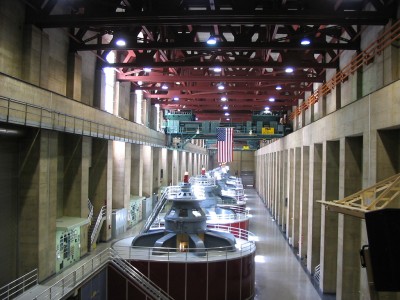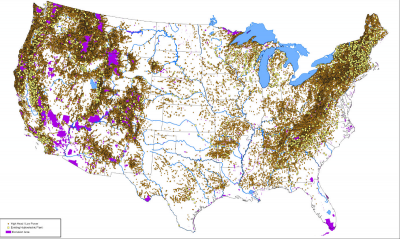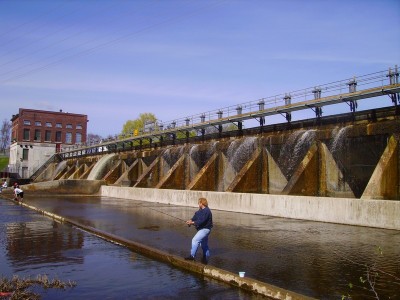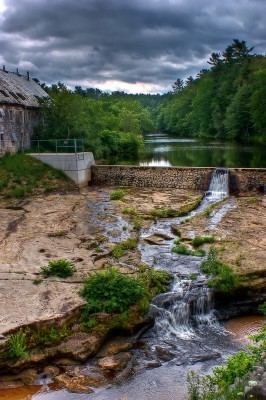A North American Energy Plan for 2030: Hydro-electricity the forgotten renewable energy resource
Posted by Neil Howes in Hydro energy No Comments» While their are no shortages of plans for the US to reduce its reliance on oil imported from overseas or replace fossil fuels with renewable resources, their is little consideration of a continental plan for future economic growth in a fossil fuel constrained world.
While their are no shortages of plans for the US to reduce its reliance on oil imported from overseas or replace fossil fuels with renewable resources, their is little consideration of a continental plan for future economic growth in a fossil fuel constrained world.
North American Oil & Electricity Consumption
The North American economy, including NAFTA partners Canada, US and Mexico, accounts for 25% of the worlds oil consumption and 25% of the worlds carbon dioxide emissions. Together, these three countries produce 4,800 TWh of electric power per year and share the world’s largest and most extensive electricity grid.
Presently 38% of this electricity is produced from carbon free sources (nuclear 19%, hydro 18% and wind energy 1.7%). North America has substantial oil, natural gas and coal reserves, exceptional potential solar and wind resources, a large hydro electric capacity, and unique natural hydro storage lakes that can be used for short and long term energy storage.
Changes Will Take Decades to Implement, Start Early
Conventional oil production, however, has been declining in all 3 countries and overseas imports from politically unstable regions have been increasing at a time when world oil production is near or past peak. While North American coal reserves are large, coal used for producing electricity is the major source of GHG emissions and will need to be dramatically reduced by 85-90% before 2050.
Both problems require urgent attention now, as changes will take decades to implement, and long term plans will need to involve all 3 of the NAFTA economies.
Most proposals to reduce oil imports, such as the Pickens plan, the Al Gore “RePower America plan, Lester Brown’s “Plan B 3.0“, Greenpeace’s “Global energy[r]evolution” and the Obama-Biden plan call for gasoline and diesel fuelled cars and trucks to be replaced by vehicles, using either electricity, flex fuels or compressed natural gas (CNG).
Electric Vehicles and Heat Pumps
Either directly or indirectly these plans would require >20% increase in electricity production to replace both oil based transport by electric vehicles, and to replace natural gas (NG) and oil used for heating with electric heat pumps, and additional increases due to increasing population and incomes. Off-setting some of these increases could be savings in electricity consumption by reducing the “electric productivity gap” (pdf), by improved insulation, and improvements in energy efficiency of appliances.
Replacing coal fired electricity would require an even larger 45% increase of today’s 556 GWa electricity production by alternative low carbon energy.
Hydro turbines in the Hoover Dam.
Photo: flickr/fusionpanda
Hydro Energy’s Potential Overlooked
Proposals for expanding carbon free electricity production generally consider expanding nuclear, wind and solar energy, but do not emphasise expanding hydro, although hydro electricity accounts for almost half of North America’s present carbon free electricity production.
Hydro energy’s potential may be overlooked because; it is “old” renewable energy, or because like nuclear energy, some hydro electric schemes have been criticized by environmental groups, but most importantly a perception by many, that most hydro electric potential in North America has already been exploited.
Hydro electricity deserves more scrutiny because;
- North America has significant undeveloped potential,
- the technology is well understood, although technical improvements continue to be made, especially for low head and small hydro,
- hydro has a very high energy return on energy investment (ERoEI),
- additional hydro can enable more wind and solar energy capacity to be absorbed by the grid,
- hydro potential is more geographically dispersed than wind and solar, and finally,
- the cost of developing additional hydro capacity is moderately low and has very low technical and financial risk.
North American Hydro Electricity Resources
Hydro electricity is presently the largest renewable electricity source in North America, with 94 GWa (35 GW in US, 50 GW in Canada and 9 GW in Mexico) generated in North America out of the 556 GWa electricity production (18%). In the US, only 35 GWa hydro production (85 GW capacity) of the estimated 300 GWa hydro potential has been developed according to a DOE Idaho National Laboratory study (pdf).
In the US, one third of the undeveloped potential is located in state or federal lands and is presently prohibited from development, one third is in remote regions making development by 2030 more difficult, while of the remaining (100GWa) feasible, non developed potential, 30 GWa is small hydro (1-30MWa) close to towns or electricity lines and roads (<1 mile) and could be developed by diverting <50% of the natural stream flow without building dams or impounding structures.
Hydro locations in the US
An additional 15 GWa of large hydro involving either adding turbines to existing dams without any hydro generation, building additional dams sites, or enhancing existing structures (raising capacity or adding additional turbines) could be developed. Thus, in the US, 45 GWa of the 100 GWa feasible potential close to roads and towns, could be developed by 2030.
Canada
Canada has 73 GWc (50 GWa) developed hydro capacity and an estimated 166-183 GWa of undeveloped hydro potential, but like the US two thirds is either remote (Yukon and NW Territories) or will probably not be developed soon due to environmental concerns, or lack of infrastructure. That’s still an impressive additional 55 GWa of hydro potential in British Columbia, Manitoba and Quebec could be developed by 2030.
Presently, more than 10 GWa additional Canadian capacity has been planned (mainly the Nelson River in Manitoba and the upper Churchill Quebec/Labrador), but both projects require long term sales contracts with US utilities before construction can commence.
Mexico
Mexico presently has 9.5 GW capacity hydro developed and considerable undeveloped potential especially small hydro, some estimates as much as 300 GWa. Doubling Mexico’s present capacity to 18 GWc would seem possible, giving a North American total of 109 GWa new hydro.
Remote Sites
To develop more than this would require development of some of the 150 GWa potential at remote sites especially in Alaska, the Yukon and NW Territories, and the Pacific NW, or building on Federal lands in less remote locations.
Reliable Peak Power
What are the prospects to develop even a small portion of the estimated >800 GWa undeveloped hydro potential by 2030? For a comparison, China with a land area similar to US, has an estimated 400 GWa hydro potential, presently has 170 GW of developed capacity (60 GWa), while 100 GWc of projects are under construction and when completed China will have developed 25% of its potential capacity.
Hydro-electricity capacity will be critical to the development of wind and solar energy because while these potential energy resources are very large, they cannot provide reliable peak power that hydro can provide. The US also has 30 GW pumped storage capacity, which can absorb 18GW of excess off-peak electricity generated by wind or nuclear energy. Canada uses much of its 73GWc as base-load power but with an improved North American grid could use more for peak demand by installing more turbines at existing dams, and replacing off-peak power with wind energy.
Inexpensive
A DOE study in 2003 indicates that enhancing existing hydro, by adding turbines to dams without any hydro capacity is relatively inexpensive ($1600/kWha). Building small hydro (1-30 MW) close to existing infrastructure can be quick and not require very much additional infrastructure. Community involvement and ownership, just as with some wind power projects, would be an advantage. Building large new hydro will generally have a longer lead time, although in some cases only requires new long term contracts with utilities to secure financing of planned projects.
The Sturgis Dam, produces 90% of the City of Sturgis’ Power,
Located in Centreville MI, 16 Miles to the North West.
Photo: flickr/Yamoneta
2030 Scenario
Sometimes no electricity transmission infrastructure is in place, or approval for building new dams or diverting stream flow is opposed by the local community, so I have estimated that only 110 GWa additional (half of the feasible capacity), non-remote hydro could be built in North America by 2030.
Alaska’s Huge Potentials
Whether any of the 150 GW hydro potential in remoter locations can also be developed, especially in Alaska, The North-West Territories or the Yukon would depend upon either a large local market, for example aluminium refining, or an electricity grid connection with the North American grid. Alaska has 40% of the US undeveloped hydro potential, 45 MW not presently excluded from development due to its location on Federal Lands. Alaska also has very considerable wind power and geothermal potential along the Pacific coastline and Aleutian Islands.
Hydro-electricity alone is not sufficient, combine with more green
Wind, together with a large hydro potential could ensure a very large (10-100 GWa) reliable supply of electricity, improving the economics of building a 3,000 km UHVDC line interconnecting via the Yukon to the Provence of Alberta and /or British Columbia to the Western Interconnect, or via Northern Manitoba to link up with existing HVDC lines to Minnesota and N Dakota and to the Eastern Interconnect. If 20% of these remote sites were developed by 2030 (10 GWa depending upon the Alaska/Yukon UHVDC line, 20 GW from Washington State, Idaho and Oregon) this would be an additional 30 GWa, bringing total new hydro to 140 GWa. Together with the existing 94 GWa hydro, this 234 Gw would be about 26% of North America’s hydro potential.
This additional electric power would enable 90 million PHEV’s or EV to be powered, and replace a third of the NG and coal used for heat and generating electricity. Hydro-electricity would then account for 42% of total electricity production. This expanded production alone cannot replace all fossil fuel use but together with improved energy efficiency it can make a large contribution as well as providing peak capacity enabling the less flexible energy sources, wind and solar to replace the remaining FF use.
Environmental Issues
This plan does not call for dams on every river and stream or for building any dams in National Parks or Federal lands where development is presently prohibited. Small hydro would use run-of–river flows diverting at most 50% of steam flows and returning the same flows up to 5 miles downstream. Expanding existing hydro projects would involve adding additional generator capacity, enlarging reservoir capacity, or adjacent upper catchment diversions into dam catchments. Developing larger schemes in remote areas would involve catchment flooding and building very long distance transmission lines similar to what is presently used to bring power from Canadian northern rivers to the Eastern Interconnect.
Mercury, Methane & CO2 Releases
While new dams in northern regions have a number of unfavourable environmental consequences, such as releasing soil mercury into the aquatic environment, and releasing methane, these have been shown to be temporary (<10 years), and methane release (pdf) is much less than dams in tropical regions.
Hydroelectricity in these environments has the lowest carbon dioxide equivalent of any energy source and >100 times less than coal fired electricity. Thus this environmental damage has to be evaluated against present and potentially disastrous damage to the environment from continued use of coal and oil.
Micro-Hydro Generation
New Minas hydro dam.
Micro-hydros need small reservoirs and
return same flows up to 5 miles downstream.
Photo: flickr/jhoc
Another means of generating hydro-power with minimal environmental impact is run-of-river micro-hydro generation, which has been proposed for relatively large scale implementation on the Mississippi river and in British Columbia (as well as finding favour in Britain, New Zealand, Norway and the Himalayas).
This article is re-published (by Dirk-Jan de Wilde, OliNo) from the The Oil Drum with permissions of the author Neil Howes. Neil is an Associate Professor at the University of Sydney.








